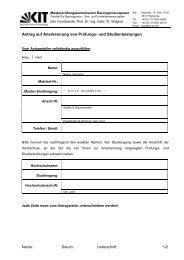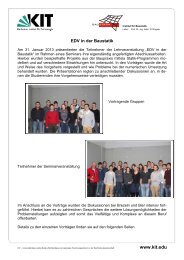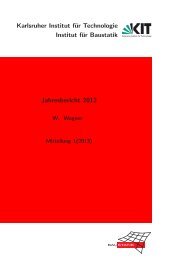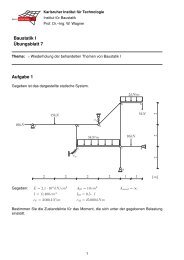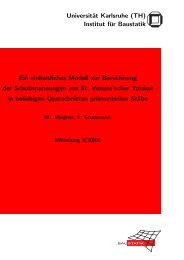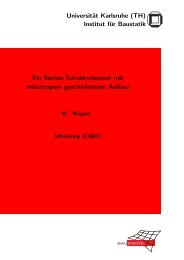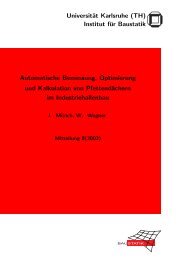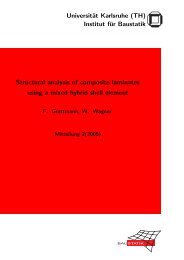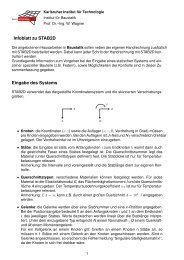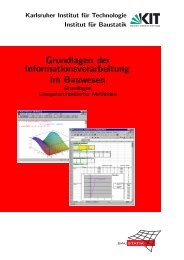Universität Karlsruhe (TH) - am Institut für Baustatik
Universität Karlsruhe (TH) - am Institut für Baustatik
Universität Karlsruhe (TH) - am Institut für Baustatik
You also want an ePaper? Increase the reach of your titles
YUMPU automatically turns print PDFs into web optimized ePapers that Google loves.
E<br />
J 2 -plasticity model for small strains<br />
The applied plasticity model is restricted to small strains, where the additive decomposition<br />
of the Green–Lagrangean strains in elastic an plastic parts is assumed. The strain energy is a<br />
quadratic function of the elastic strains. We use an associative flow rule and a J 2 yield criterion<br />
with linear isotropic hardening. The constitutive equations are summarized as follows:<br />
kinematic assumption E = E e + E p<br />
elastic part of the free energy ψ(E e ) = λ (trE 2 e) 2 + G tr(E 2 e)<br />
Second Piola–Kirchhoff stresses S = ∂ Ee ψ<br />
linear isotropic hardening y(e p ) = y 0 + Ke p<br />
yield criterion Φ = √ 3<br />
2 p)<br />
associative flow rule Ė p = γ∂ S Φ<br />
evolution of e p ė p = √ 2<br />
||Ėp|| 3<br />
loading unloading conditions<br />
γ ≥ 0, Φ ≤ 0, γΦ=0<br />
(70)<br />
Eν<br />
Here, the L<strong>am</strong>é par<strong>am</strong>eter λ is related to the elasticity constants by λ = , G denotes<br />
(1+ν)(1−2ν)<br />
the shear modulus, y 0 the initial yield stress and K the plastic tangent modulus. The rate<br />
equations are integrated with a backward Euler algorithm. The stress tensor is linearized to<br />
obtain the consistent tangent matrix ¯C introduced in (60).<br />
Remark:<br />
The definition of the deviatoric part of the Second Piola–Kirchhoff stress tensor for finite<br />
strain kinematics is<br />
Dev S = S − 1 3 [S : Ĉ]Ĉ−1 . (71)<br />
Since Ĉ =(1 +2E), then for small Green–Lagrangean strains (i.e. when ‖E2 ‖≪‖E‖ ≪1)<br />
it follows that<br />
Dev S = S − 1 [S : 1]+O(‖E‖) =devS + O(‖E‖) . (72)<br />
3<br />
Here O(‖E‖) denotes the terms which tend to zero as ‖E‖ approaches zero. Thus, when<br />
strains are restricted to be small, an approximate definition of the deviatoric stress tensor<br />
may be employed. Therefore in problems where finite rotations may be present but strains<br />
are restricted to be small, the above constitutive Eqs. (70) describe the small strain von Mises<br />
elasto–plasticity model. In this context we refer to [42].<br />
29




